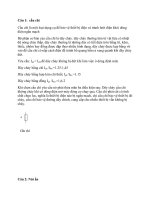môn nhập môn chuyên ngành chủ đề máy cắt kim loại laser
Bạn đang xem bản rút gọn của tài liệu. Xem và tải ngay bản đầy đủ của tài liệu tại đây (3.56 MB, 15 trang )
<span class="text_page_counter">Trang 1</span><div class="page_container" data-page="1">
<b>TRƯỜNG ĐẠI HỌC CÔNG NGHIỆP TP.HCM</b>
<b>BÁO CÁO GIỮA KỲ</b>
<b>MÔN : NHẬP MÔN CHUYÊN NGÀNHGVHD: VÕ NGỌC YẾN PHƯƠNGCHỦ ĐỀ: MÁY CẮT KIM LOẠI LASER</b>
<b>LỚP : DHCT18ATT</b>
<b>Thành phố Hồ Chí Minh, Tháng 01, năm 2024</b>
<b>1</b>
</div><span class="text_page_counter">Trang 2</span><div class="page_container" data-page="2"><b>LỜI MỞ ĐẦU</b>
Để bài báo cáo này đạt kết quả tốt đẹp, Nhóm đã nhận được sự hỗ trợ, giúp đỡcủa cơ. Với tình cảm sâu sắc, chân thành, cho phép Nhóm gửi lời cảm ơn đếncác bạn trong lớp học phần DHCT18ATT đã tạo điều kiện và hợp tác cho nhómthực hiện bài báo cáo giữa kì.
Trước hết, nhóm xin gửi tới các thầy cô Trường Đại học Công Nghiệp lời chàotrân trọng, lời chúc sức khỏe.Với sự quan tâm, dạy dỗ tận tình của thầy cơ,nhóm chúng em đã hồn thành xong bài báo cáo tiểu luận này.
Đặc biệt nhóm 1 xin gửi lời cảm ơn chân thành nhất tới cô Võ Ngọc PhươngYến đã quan tâm và hướng dẫn tận tình để nhóm có thể hồn thành tốt bài báocáo trong thời gian qua.
Khi làm bài báo cáo này, nhóm chúng em cịn thiếu nhiều kinh nghiệm nên có thể dẫn đến sai sót. Nhóm chúng em rất mong nhận được sự chỉ bảo và đóng gópý kiến của thầy cơ để nhóm ngày càng một tốt hơn.
Nhóm chúng em xin chân thành cảm ơn!
<b>Thành phố Hồ Chí Minh, ngày 5 tháng 03 năm 2024</b>
<b>2</b>
</div><span class="text_page_counter">Trang 4</span><div class="page_container" data-page="4"><b>2.1The birth of metal laser cutting machines...5</b>
<b>2.2 The popularity and applications of metal laser cutting machines today...6</b>
<b>III.Operating principle of laser cutting machines...7</b>
<b>3.1 Operating principle...7</b>
<b>The most popular types of metal laser cutting machines today...7</b>
<b>IV.Structure of laser metal cutting machine...11</b>
<b>V. Operating principle and applications of CNC laser cutting machine...12</b>
<b>Too long to read on</b>
<b>your phone? Save</b>
to read later onyour computer
Save to a Studylist
</div><span class="text_page_counter">Trang 5</span><div class="page_container" data-page="5"><b>I.Introduction to the machine</b>
A metal laser cutting machine, also known as a laser cutter or laser cutting system for metal, is a highly precise and efficient tool utilized in industrial settings for cutting various types of metal sheets and plates. Metal laser cutting machines are widely used in industries such as automotive, aerospace, electronics, and manufacturing due to their versatility, reliability, and ability to produce high-quality finished products. They are capable of cutting a wide range of metals, including steel, stainless steel, aluminum, copper, and brass, making them indispensable tools for modern metal fabrication and production processes.
The laser, which stands for "Light Amplification by Stimulated Emission of Radiation," was invented in 1960 by the physicist Theodore Maiman. This invention revolutionized various fields, including manufacturing, medicine, telecommunications,and research, due to its precise and controllable beam of light.
In 1960, Theodore Maiman successfully created the world's first ruby laser, based on Albert Einstein's theory of stimulated emission, which was discovered in 1917. After years of research and development, in November 1967, Maiman successfully patented the world's first laser. It was a significant milestone in the history of technology and science, opening up a range of new applications for laser technology.
<b>II.1 The birth of metal laser cutting machines</b>
After Maiman's invention was announced in 1960, the Western Electric Engineering Research Center produced the first laser cutting machine in 1965. However, its application was limited, mainly used for drilling holes in diamonds.
Two years later, British scientists began using laser cutting machines to cut metal using oxygen as an assist gas (a necessary component for laser cutting machines to operate).
By 1970, laser cutting technology had been further improved, and experiments began to cut Titanium for aerospace applications. Subsequently, through extensive research, scientists gradually replaced oxygen assist gas with CO2 gas, leading to the creation ofCO2 laser cutting machines. However, CO2 machines couldn't cut metals; they were primarily used for cutting non-metallic materials like plastics, fabrics, and leather.With this foundation, over the years, inventors developed various types of laser cuttingmachines capable of cutting a wider range of materials with higher precision and efficiency compared to older laser machines.
<b>5</b>
</div><span class="text_page_counter">Trang 6</span><div class="page_container" data-page="6"><b> 2.2 The popularity and applications of metal laser cutting machines today</b>
Today, metal laser cutting machines are widely utilized across numerous industries due to their exceptional precision, speed, and versatility. Some key applications and areas of prevalence include:
<b>1. Manufacturing and Fabrication: Metal laser cutting machines are extensively </b>
used in manufacturing and fabrication industries to precisely cut and shape metal components for various products such as automotive parts, aerospace components, machinery parts, and consumer electronics.
<b>2. Automotive Industry: Laser cutting technology is commonly employed in the </b>
automotive industry for manufacturing vehicle body panels, chassis components, exhaust systems, and intricate automotive parts.
<b>3. Aerospace and Defense: Metal laser cutting machines play a crucial role in the </b>
aerospace and defense sectors for fabricating lightweight yet durable components, including aircraft frames, turbine parts, missile components, and armor plating.
<b>4. Construction and Architecture: Metal laser cutting machines are used in </b>
construction and architecture for cutting metal sheets and profiles to create customizedbuilding components, decorative elements, structural frames, and signage.
<b>5. Medical Devices: In the medical field, metal laser cutting machines are utilized for </b>
producing intricate components for medical devices and equipment, such as surgical instruments, implants, and diagnostic tools.
<b>6. Electronics and Technology: Metal laser cutting machines are employed in the </b>
electronics industry for fabricating precise metal components used in electronic devices, circuit boards, computer hardware, and telecommunications equipment.
<b>7. Jewelry and Fashion: Laser cutting technology is applied in the jewelry and </b>
fashion industries to create intricate and detailed designs on metal pieces, including custom jewelry, accessories, and decorative items.
<b>8. Rototyping and Rapid Manufacturing: Metal laser cutting machines are used in </b>
prototyping and rapid manufacturing processes to quickly produce prototypes, batch production runs, and custom-designed parts with high precision and minimal material waste.
<b>small-6</b>
</div><span class="text_page_counter">Trang 7</span><div class="page_container" data-page="7">Overall, the widespread adoption of metal laser cutting machines has significantly contributed to the advancement of manufacturing processes, enabling faster production, enhanced design flexibility, and improved quality in a wide range of industries.
<b>III. Operating principle of laser cutting machines </b>
<b> 3.1 Operating principle </b>
The characteristics and operating principles of laser cutting machines can be described as follows:
Highly Directional Laser Beam: The laser beam emitted from the laser source ishighly directional, meaning it is focused onto a small point on the surface of thematerial to be processed.
High Intensity: The laser beam has a high energy intensity, sufficient to melt or even vaporize the material it is directed at.
Reflection and Absorption The laser beam incident on the material surface can either reflect or be absorbed. In the absorption process, the energy from the laser beam is converted into heat, melting the region of the material.
Creation of Cutting Path: After the material surface is melted, a cutting path is created through the movement of the molten material. The laser beam can be moved in the horizontal (X-Y) direction or through a mirror system to create desired cutting lines or shapes on the material surface.
In summary, laser cutting machines operate by using a laser beam to heat the region ofthe material to be processed, then creating desired cutting paths or shapes through the movement of the laser beam and the molten material.
<b>The most popular types of metal laser cutting machines todayCO2 laser cutting machine</b>
- The CO2 laser cutting machine operates based on the impact of a CO2 gas stream. This type of machine is typically used for processing materials with a thickness of 5mm and above. Its main advantage lies in its ability to cut metal in straight lines with precision, resulting in sharp and aesthetically pleasing finished surfaces. Consequently, the processed parts exhibit high-quality uniformity and, notably, do not incur additional processing costs.
- The operating principle of the CO2 laser cutting machine involves generating a highly energetic laser beam capable of heating and vaporizing the material. Thismachine has a very small focal point, resulting in precise and accurate cutting
<b>7</b>
</div><span class="text_page_counter">Trang 8</span><div class="page_container" data-page="8">lines. It can automatically cut various types of metal materials thanks to programmed CNC control systems.
pre-- The structure of a CO2 laser cutting machine consists of the main machine system, dust extraction system, laser source, and smoke pump. The main machine system includes key components such as the machine frame, machine bed, and motion mechanism.
- CO2 laser cutting machines have a lower initial investment cost compared to fiber laser cutting machines. They are commonly used for cutting a wide range of materials, from alloys to non-metals such as mica, wood, ceramic, leather, stone, and common metals. However, they may not be suitable for highly reflective metals like copper and aluminum.
<b>8</b>
</div><span class="text_page_counter">Trang 9</span><div class="page_container" data-page="9"><b> Fiber Laser Cutting Machine</b>
- This is a type of machine that applies fiber optic technology and a speed transmission system. Fiber laser cutting machines typically operate at very high speeds and provide high efficiency in production. This type of machine can accurately process metal materials such as stainless steel, iron, steel, aluminum, copper, etc.
high-- This is a type of machine that is known for its stable operation and high efficiency, helping businesses save on electricity consumption. When comparing the electricity consumption of this machine with CO2 laser machines, the energy consumption is only about 25%.
- The operating principle of a Fiber Laser cutting machine involves using a laser beam to heat the material, after which a gas stream is blown out from the cutting nozzle. This gas stream's purpose is to blow away the molten metal from the material area, thereby creating the cutting path.
- The Fiber Laser cutting machine uses three types of auxiliary gases: N2, O2,and compressed air. Depending on the customer's requirements for the quality of the cut or depending on the type of material to be processed, the appropriate gas type will be chosen. O2 gas is typically used for cutting steel, N2 gas is used for cutting stainless steel, aluminum, and copper. Compressed air is commonly used for cutting steel with a thickness below 5mm.
<b>9</b>
</div><span class="text_page_counter">Trang 10</span><div class="page_container" data-page="10"><b>10</b>
</div><span class="text_page_counter">Trang 11</span><div class="page_container" data-page="11"><b>IV.Structure of laser metal cutting machine</b>
Current metal laser cutting machines typically consist of four main components: the main machine system, the circulating cooling system, the laser source, and the smoke and dust extraction system. Each component plays a different role:
<b>- Main Machine System: This comprises the frame, worktable, and motion </b>
mechanism. It is responsible for providing the structural support and mechanical movement required for accurate and precise cutting operations.
<b>- Circulating Cooling System: This system ensures that the components of </b>
the laser cutting machine, particularly the laser source, remain at optimal operating temperatures during operation. It circulates coolant or water through the machine to dissipate heat generated by the laser source and other components.
<b>- Laser Source: The laser source generates the high-energy laser beam used </b>
for cutting metal. Common types of laser sources include fiber lasers and CO2 lasers. The laser source is a critical component that determines the cutting capabilities and efficiency of the machine.
<b>- Smoke and Dust Extraction System: This system removes the smoke, </b>
fumes, and dust generated during the cutting process to maintain a clean andsafe working environment. It typically includes a suction fan or pump, ductwork, and filters to capture and remove airborne contaminants effectively.
Together, these components work in tandem to ensure the efficient and reliable operation of metal laser cutting machines, enabling precise and high-quality cutting of various metal materials.
<b>11</b>
</div><span class="text_page_counter">Trang 12</span><div class="page_container" data-page="12"><b>V.Operating principle and applications of CNC laser cutting machine</b>
Phase 1: The CNC laser cutting machine produces highly energetic laser beams capable of heating the material. These laser beams are focused into a single point on the surface of the material using a lens system.
Phase 2: After being directed onto the material surface, these laser beams utilize their high heat energy to burn the surface of the material being processed. This causes the region of material to melt, and the portion affected by the high temperature melts awayfrom the processing area.
Phase 3: Finally, the region of material that has been burned moves along a
predetermined path and creates a cut according to the programmed design or drawing. To accomplish this, the converging laser beams move via the CNC mirror system and the fiber guide system, or the material sheet is moved on the CNC machine table alongthe X-Y axes.
With the information provided above, it is hoped that you have gained a better understanding of CNC laser cutting machines. Understanding the operating principles
<b>12</b>
</div><span class="text_page_counter">Trang 13</span><div class="page_container" data-page="13">of these machines, as well as their applications, will assist businesses in selecting the most suitable cutting machine to optimize their production and business operation
<b>13</b>
</div>





